Numbers, Patterns, and Shapes: Later Abstractions of the 1960s and 1970s
-
 7362 (1967) by Pat O'Neill
7362 (1967) by Pat O'Neill
-
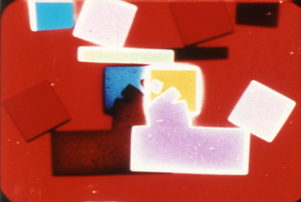 Kitsch in Synch (1975) by Adam Beckett
Kitsch in Synch (1975) by Adam Beckett
-
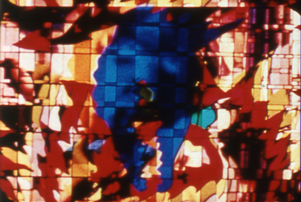 Kitsch in Synch (1975) by Adam Beckett
Kitsch in Synch (1975) by Adam Beckett
-
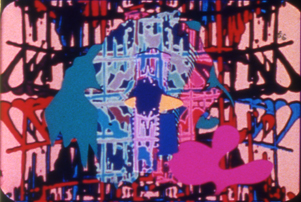 Kitsch in Synch (1975) by Adam Beckett
Kitsch in Synch (1975) by Adam Beckett
-
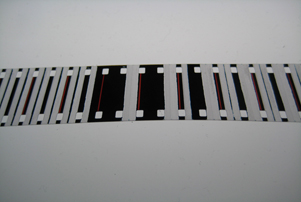 Light Traps (1975) by Louis Hock
Light Traps (1975) by Louis Hock
-
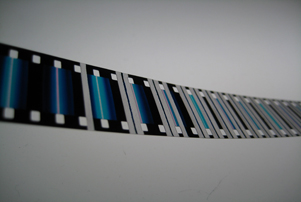 Light Traps (1975) by Louis Hock
Light Traps (1975) by Louis Hock
-
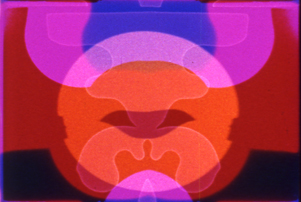 7362 (1967) by Pat O'Neill
7362 (1967) by Pat O'Neill
-
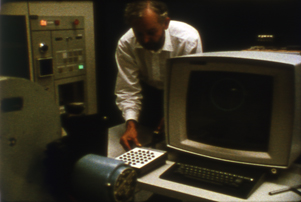 Experiments in Motion Graphics (1967) by John Whitney
Experiments in Motion Graphics (1967) by John Whitney
May 3, 2012, 7:30PM
at Cinefamily, 611 N. Fairfax Ave., Los Angeles 90036
Early in Alternative Projections we presented Early Abstractions of the 1940s and 1950s, which presented an evolution of imagery in films from abstracted sculptural shapes to abstract images created by animation and optical printer. We continue looking at the evolution with more remarkable abstract films. As in the earlier show, John and James Whitney continue as key figures, but working separately. John Whitney’s 1967 Experiments in Motion Graphics introduces the possibilities of computer animations, soon to be fully explored. The classic films 7362 by Pat O’Neill’s and Kitsch in Synch by Adam Beckett reveal some of the unbelievable possibilities of optical printer work. Jules Engel’s Train Landscape uses traditional animation. Michael Scroggins worked with pioneering video manipulation. And then the age of the computer was upon us.
In person: Larry Cuba, Louis Hock, Pat O’Neill, Michael Scroggins, John Whitney Jr. (schedules permitting)
For full information, please visit http://tinyurl.com/6wdjldz and http://tinyurl.com/86nw2qp
Tickets: $12 general; free for Filmforum and Cinefamily members, see http://www.brownpapertickets.com/event/241557
Additional films TBA.
Films to be Screened
-
 Experiments in Motion Graphics (1967) by John Whitney
Experiments in Motion Graphics (1967) by John Whitney
Experiments in Motion Graphics (1967, 16mm, color, sound, 12min.)
Directed by John WhitneyNewly restored print from the Academy Film Archive!
Developed from a talk he had given in Aspen, Experiments in Motion Graphics is a fascinating and unique film document in which John Whitney explains the technical and creative processes behind the creation of his pioneering computer animation work (in this case, the classic Permutations).
-
 7362 (1967) by Pat O'Neill
7362 (1967) by Pat O'Neill
7362 (1967, 16mm, b/w & color, sound, 11min.)
Directed by Pat O'Neill“This Film started out to be about the motion and sound of the oil derricks that once lined the beach in Venice, California. The derricks, which had been built during the oil boom of the 1920s, were made of wood and rusted iron, and were largely open and unattended. I was attracted to these towers by their moaning sounds, their heady aromas, and the consolation of the endless rising and falling of the pump heads. Somehow it seemed like prayer. The film came to contain a human body, and then moving objects which I filmed in my studio: rotating and oscillating shapes whose outlines would merge with one another. But in a way the piece was really about re-photography – about making something out of ordinary parts using mechanical technology to reveal a glimpse of something uncanny.
“Thirty-some years later, it seems to be about orgasms. Joseph Byrd, later of the United States of America (a band) made sounds on the fly from a primitive synthesizer. Burton Gershfield stopped by with a gallon each of yellow, cyan, and magenta developers from Technicolor, which were used to develop black and white, emulsion 7362.” (Pat O’Neill)
-
Matrix III (1972, 16mm, color, sound, 10min.)
Directed by John WhitneyOne of John Whitney's late masterworks, this restrained, powerful computer animation piece is set to Terry Riley's 'Poppy Nogood and the Phantom Band', from his A Rainbow in Curved Air album.
-
Train Landscape (1974, 16mm, color, sound, 3min.)
Directed by Jules Engel“A passing landscape as seen through the window of a moving train ... after the first minute or so, we forget the narrative as we become wholeheartedly involved with the energy of the optical statement being scrolled out before us.” (Lorettann Devlin Gascard)
-
 Kitsch in Synch (1975) by Adam Beckett
Kitsch in Synch (1975) by Adam Beckett
Kitsch in Synch (1975, 16mm, color, sound, 5min.)
Directed by Adam BeckettRestored print courtesy of The iotaCenter/Academy Film Archive.
“This is an abstract animation that seems to get laughs. The soundtrack is why, mainly; it sounds like a large group of demented ducks enthusiastically and persistently seeking oneness with the all, via energetic chanting. BUBUBABU!!! The imagery is elaborate, brightly colored, and every single damned beat in the soundtrack has its own little bump.” (Adam Beckett)
-
 3/78 by Larry Cuba
3/78 by Larry Cuba
3/78 (Objects and Transformations) (1978, 16mm, b/w, sound, 6min.)
Directed by Larry Cuba“Sixteen ‘objects’, each consisting of one hundred points of light, perform a series of precisely choreographed rhythmic transformations. Accompanied by the sound of a Shakuhachi (the Japanese bamboo flute), the film is an exercise in the visual perception of motion and mathematical structure.” (Larry Cuba)
-
 Light Traps, by Louis Hock
Light Traps, by Louis Hock
Light Traps (1975, 16mm, color, silent, 8min.)
Directed by Louis HockPrint courtesy of Louis Hock and the Academy Film Archive.
“A dance metered between the tempo of 60 cycles per second of electrified gas and camera shutter, further wrought by manual, etched harmonics. Las Vegas in a closet.” (Louis Hock)
-
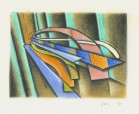 Furies, by Sara Petty
Furies, by Sara Petty
Furies (1977, Digital video, transferred from 16mm, color, 3.5 min.)
Directed by Sara PettyIn Furies this image transformation is given structure by the music, but music chosen specifically to express quickness and surprise, as suggested by cats themselves. Quoting Franz Marc: Is there a more intriguing idea for an artist than to imagine the way that nature can be seen through the eye of an animal?...we should try to immerse ourselves in the animals' souls to enable us to discover the images they see. SP -
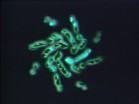 Recent Li, by Michael Scroggins
Recent Li, by Michael Scroggins
Recent Li (1980, 5:00, video)
Directed by Michael Scroggins“In defining the Chinese term ‘li’, Joseph Needham has written, ‘In its most ancient meaning, it signified the pattern in things, the markings in jade or fibers in muscle…’ The forms in Recent Li originate from the ‘li’ generated in the layered real-time performance of a video feedback quaternity figure.” (Michael Scroggins)
-
 Two Space, by Larry Cuba
Two Space, by Larry Cuba
Two Space (1979, HD (orig. 16mm), b/w, sound, 8min.)
Directed by Larry Cuba“Two Space began demurely: small white dots formed tile-like linear figures over the black background, entering a similar but mathematically transformed trajectory at regular intervals. For example, a figure that consisted of an upper-right-to-lower-left diagonal might appear as an upper-left-to-lower-right diagonal during its next reprisal. Each rendition comprised part of a larger cycle, and successive cycles explored increasingly complex originating figures. The repeating array was just large enough to give the impression of an infinite plane of dancing dots extending beyond the screen's limits, and just small enough so that each delicate pattern may be recognized and appreciated as and by itself. To the riveting chime of gamelan music the figures continued their geometrically exacting traceries with a strange ascetic beauty: how could such basic elements converge to inspire such rich satisfaction? It was as though one had been transported to Athenian days, when the coincidence of art, symmetry, and piety was inevitable and inviolate. Indeed, the film's pure abstraction invited far-flung associations from the primal flourish of Southeast Asian batik to the boundless intricacies of Byzantine tiles. Two Space thus approached a state of virtually infinite aesthetic and psychical resonance through the very exactitude of its limitations.” (Victoria Meng)
-
Kang Jing Xiang (1982, 16mm, color, silent, 13min.)
Directed by James WhitneyPrint courtesy of the Whitney Collection at the Academy Film Archive.
Though fully shot and roughly assembled by James Whitney prior to his death in 1982, this film – third part of an intended quartet – was completed and printed after his passing by William Moritz and Mark Whitney.